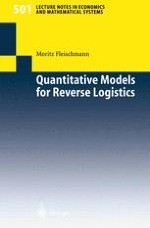2001 | OriginalPaper | Buchkapitel
Impact of Inbound Flows
verfasst von : Dr. Moritz Fleischmann
Erschienen in: Quantitative Models for Reverse Logistics
Verlag: Springer Berlin Heidelberg
Enthalten in: Professional Book Archive
Aktivieren Sie unsere intelligente Suche, um passende Fachinhalte oder Patente zu finden.
Wählen Sie Textabschnitte aus um mit Künstlicher Intelligenz passenden Patente zu finden. powered by
Markieren Sie Textabschnitte, um KI-gestützt weitere passende Inhalte zu finden. powered by
As revealed in the previous chapter, one of the major distinguishing characteristics of inventory control in a Reverse Logistics context is the need for integrating a largely exogenously determined goods inflow. In this chapter we address this issue in more detail and quantify the impact of inbound goods flows on inventory dynamics and appropriate control strategies. For the sake of focus we start from a basic situation allowing for a detailed analysis. Subsequently, potential extensions and limitations of this approach are discussed. As with many of the models discussed in the previous chapter, we therefore aggregate the two inventory types distinguished in the framework of Figure 6.1 into a single stock point. Moreover, we assume demand and returns to be independent. Finally, we do not include a disposal option, hence procurement is the only means to control the system. One may view this setup as the common core of the models discussed in Chapter 6. Our goal is to identify appropriate decision rules in the above setting and to investigate the impact of the return flow on the system’s performance.
